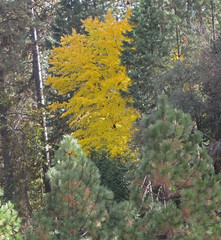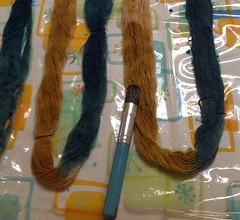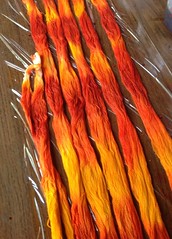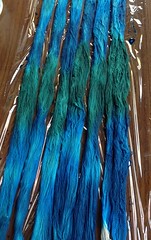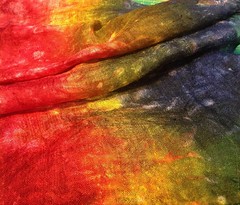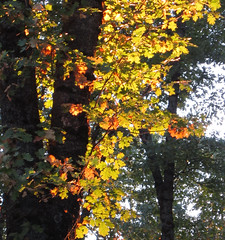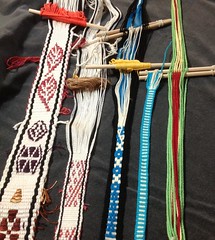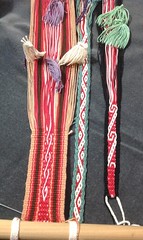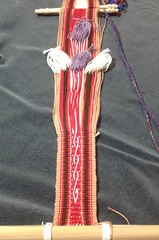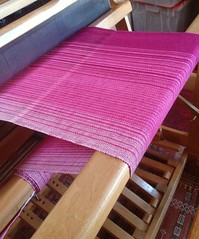Square One
It's good, as an adult, and as a teacher of adults, to learn new things every now and then. It helps me learn other ways of teaching, learn how it feels to be a student again, and it also keeps the little grey cells from deteriorating as fast as they might. Or so I would like to think!
I've been learning to sew leather, to make bags, and have chronicled some of my efforts. After many attempts, both by machine and by hand, which were less than stellar, I was determined to find someone to show me the ropes. I've searched for classes, most were far away or inaccessible for some reason or another, but at last, by sheer chance, I found a somewhat local teacher, willing to take on individual students. Local... well, within easy driving distance, and this week I had my first lesson:
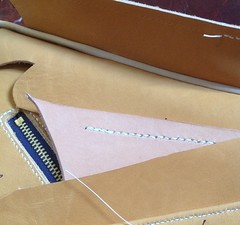
I learned how to hand stitch leather. Or, I should say, "I am learning" for clearly, much practice is needed. But I learned about weights of leather, sizes of thread, thread quality, needle sizes, and other tools, both basic and specialized. I learned more than I could learn, rather, I heard more than I could take in.
Like many hand skills, the basic technique is not difficult, but it requires practice to perfect. My stitches are quite uneven, but as I watched my teacher, and listened to him describe the process, I learned a *ton* that I could not grasp just watching YouTube or Craftsy classes. In person instruction, from a master, is priceless. I am so happy to have found him!
I learned what good stitches look like, even though mine are not there yet. I learn how to hold a tool, at what angle, and how, when the angle changes, the stitches change. As I tried stitching, he showed me how to hold my hands, how to pull the thread, and how tight to pull on the needles. He told me of pitfalls, things to watch out for, ways of working. I need to practice, and I will, and then I will take work to him for critique.
I was boggled by the end of the day. Getting confused. Unable to formulate my thoughts, much less be coherent. I simply could listen, write, and nod. I was tense, my shoulders hurt. Learning a new vocabulary, a new set of tools, new hand movements, a new medium entirely, made for a long day.
So, yesterday I "ran home to mama" and wove some cloth. Handspun cotton cloth, soon to be a garment:
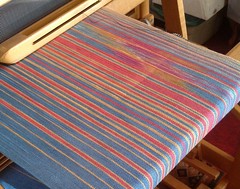
It was nice to feel competent again! Bang out a few yards, feel capable, and relax into a well-known groove.
Happy Thanksgiving to those who celebrate. May you enjoy good food and good company, and light a warm glow to carry you through, as we head into the dark of the year.
I've been learning to sew leather, to make bags, and have chronicled some of my efforts. After many attempts, both by machine and by hand, which were less than stellar, I was determined to find someone to show me the ropes. I've searched for classes, most were far away or inaccessible for some reason or another, but at last, by sheer chance, I found a somewhat local teacher, willing to take on individual students. Local... well, within easy driving distance, and this week I had my first lesson:

I learned how to hand stitch leather. Or, I should say, "I am learning" for clearly, much practice is needed. But I learned about weights of leather, sizes of thread, thread quality, needle sizes, and other tools, both basic and specialized. I learned more than I could learn, rather, I heard more than I could take in.
Like many hand skills, the basic technique is not difficult, but it requires practice to perfect. My stitches are quite uneven, but as I watched my teacher, and listened to him describe the process, I learned a *ton* that I could not grasp just watching YouTube or Craftsy classes. In person instruction, from a master, is priceless. I am so happy to have found him!
I learned what good stitches look like, even though mine are not there yet. I learn how to hold a tool, at what angle, and how, when the angle changes, the stitches change. As I tried stitching, he showed me how to hold my hands, how to pull the thread, and how tight to pull on the needles. He told me of pitfalls, things to watch out for, ways of working. I need to practice, and I will, and then I will take work to him for critique.
I was boggled by the end of the day. Getting confused. Unable to formulate my thoughts, much less be coherent. I simply could listen, write, and nod. I was tense, my shoulders hurt. Learning a new vocabulary, a new set of tools, new hand movements, a new medium entirely, made for a long day.
So, yesterday I "ran home to mama" and wove some cloth. Handspun cotton cloth, soon to be a garment:

It was nice to feel competent again! Bang out a few yards, feel capable, and relax into a well-known groove.
Happy Thanksgiving to those who celebrate. May you enjoy good food and good company, and light a warm glow to carry you through, as we head into the dark of the year.
